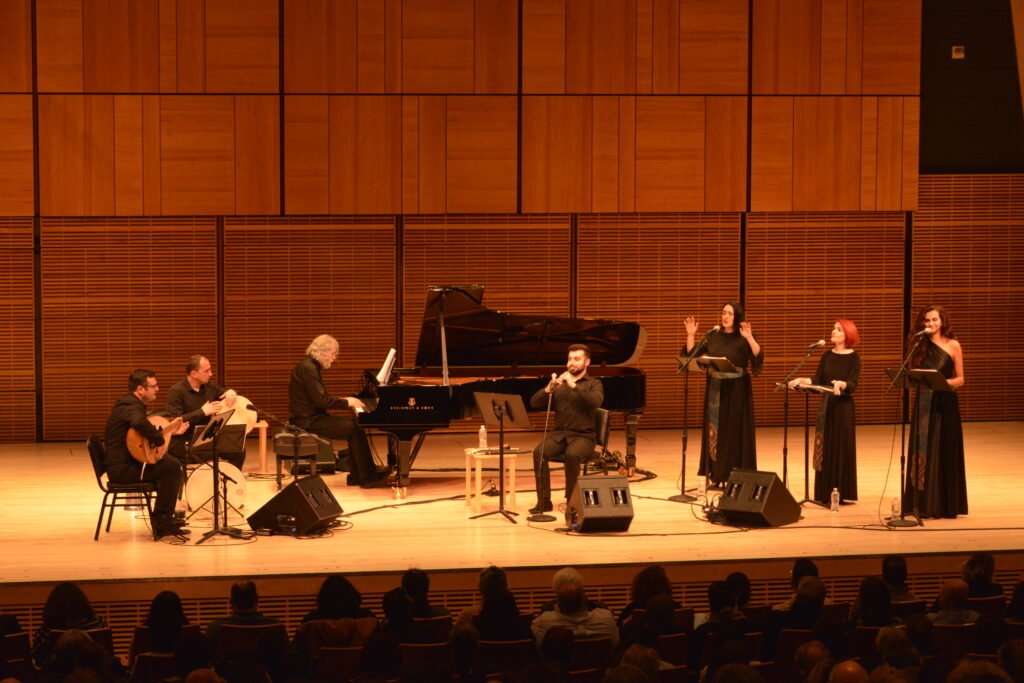
NEW YORK, NY—On Saturday, March 11, 2023, the Naghash Ensemble made its New York City debut at Carnegie Hall to a sold-out audience at the 38th Musical Armenia concert sponsored by the Eastern Prelacy of the Armenian Church.
The ensemble humbly took the stage in traditional all-black concert dress; its three female vocalists wore decorated sashes around their waists. The ensemble consisted of Aramayis Nikoghosyan on oud; Tigran Hovhannisyan on dhol, daf and dumbeg; John Hodian on piano; Harutyun Chkolyan on duduk, shvi, pku and zurna; and vocals by Hasmik Baghdasaryan (soprano), Tatevik Movsesyan (soprano/mezzo soprano) and Arpine Ter-Petrosyan (alto). Aside from Hodian, all members are born and raised in Armenia. Narration of the poems that inspired each original composition was provided by Garen Hamamjian, a candidate for the priesthood of the Armenian Apostolic Church and a student at St. Nersess Armenian Seminary.
The first half of the concert included pieces based on poems by the ensemble’s namesake, Mkrtich Naghash, an Armenian medieval poet who was born in Bitlis in 1394 and died in 1470. Hodian told Naghash’s story during the first set, explaining that during that time in history, people of multiple religions were living in relative peace in the Ottoman Empire. However, Naghash built a church with a steeple higher than most of the mosques. He refused to take down the steeple and was forced into exile. The poems that inspired the musical pieces are all that are left of Naghash. Hodian felt that writing music based on poems about exile continues to capture the Armenian experience, even today. This portion included live performances of “Meditation on Greed,” “If in this World by Sin You Wander,” “Lamentations on the Death of a Child” and “Woe to Those That Keep a Grudge.”

The second half of the concert was a last-minute change by the ensemble and based on theological poems by Kostantin Erznkats’i, who was born around 1250 and died around 1320. These were newer pieces for the ensemble and more experimental than the first half of the concert. They included “Another Answer,” “Futile Judgment,” “The Work of Darkness” and “Agvor Es.” Their excitement, joy and playfulness around performing newer material was palpable.
The ensemble instantly drew the audience in and cut to a deep emotional core. The musicians displayed a strong connection to each other and the music. They impeccably executed tight harmonies and rhythmic changes, with eye contact, body language and synchronized breathing that demonstrated a flow state indicative of true professionals. The general format for many of the pieces began with an ethereal musical presence and built into more concrete rhythmic structures. The variation between these styles allowed for a range of reactions to the music – moments for meditation followed by moments that could encourage movement or dancing. The influence of Hodian’s background as a film composer is evident in his pieces, but he also took the audience on a journey through Armenian music, jazz, medieval sounds, a capella chants, Western folk, modern classical and more. There is an expert use of tension and release, with dedicated moments of silence that allow for processing, for breathlessness and for discomfort while wondering what will happen next. “It made me feel as if Lord of the Rings was set in Armenia,” said Davit Gregorian of New York, who was in the audience. The pastoral elements of the music could evoke both a connection to and longing for the homeland.
Each ensemble member brought a special quality of their unique talent to contribute to the whole. Baghdasaryan angelically floated on her high notes, exemplifying Hodian’s inspiration when he heard her sing in the monastery. Her voice was the catalyst to form this ensemble. Movsesyan displayed an incredible range throughout the pieces and appears to be able to sing anything. She can carry both high soprano notes and low alto parts, often with the most difficult job of holding the middle harmony with precision and ease. Ter-Petrosyan was striking on her alto notes. The depth of her tone seemed to reach to the center of the earth. She is affectionately known as “Arpi Alto” online and has a large following due to her resonant contralto voice. In addition to the three vocalists, each instrumentalist played an important role. Nikoghosyan played challenging and intricate passages with relaxation and ease. Hovhannisyan steadily played the various rhythmic structures that allowed for the ensemble to stay together. According to Hodian, Hovhannisyan will take the parts that were written for the rhythmic instruments and embellish them to make them even better. Chkolyan expertly moved between the various wind and reed instruments, capturing the essence of each, from the gut-wrenching sounds of the oud to the strong horn-like sounds of the zurna. All were held together by Hodian, who not only meticulously composed each piece, but also played the piano and conducted the ensemble at the highest standard.

Perhaps one of the most impactful pieces in the program was “Lamentations on the Death of a Child.” Naghash wrote the poem after his son fell in battle. The piece began with just female voices and piano, like the sound of mothers in mourning. The grief was palpable, especially in light of the devastating Artsakh War. A more modern vocal placement rather than round operatic tones was also implemented in this piece, further reinforcing a connection to modern times. The use of all women vocalists in the ensemble provides an interesting platform for the feminine voice to be amplified, as it is often silenced in the traditional patriarchal Armenian society. It was reminiscent of how slaves utilized the blues for self-expression of their work and hardships; some of the same techniques such as call-and-response were implemented here as well.
“I was very happy it was a sold-out hall, and the crowd was half Armenian and half non-Armenian,” he told the Weekly. “So far, all of the concerts we have played (except for one), have been sold out, and I am hoping we come back to North America again sometime in the next two years.”
Ter-Petrosyan shared her feelings about performing and visiting New York for the first time. “It was astonishing, especially because it was the first time in New York and in the beautiful Carnegie Hall. I am so excited, and it’s so important that I am here. It’s the first time, but I hope it’s not the last time!”
During intermission, audience members shared their impressions of the ensemble with the Weekly. “I feel every song in my body. I feel like I am crying, dancing and having chills, and I feel like their songs are coming up from the earth,” enthused Christopher Janigian of New York City.
“I thought the whole ensemble was quite beautiful, and it was very spiritual,” said Lori Messerlian of New York. “It had parts of Armenian culture but also modernized with today’s music – timeless but timely.”
The ensemble has now concluded its North American tour, but the group has more performances scheduled in the Netherlands, Belgium, Germany and Luxembourg in April and May. The tour schedule and further information can be found at www.naghashensemble.com.



I don’t know the first thing about music theory and my cabinmates at Camp Haiastan would forbid me to sing Mer Hairenik because it came dangerously close to an act of treason. But I can listen to Gomidas and Sayat Nova for hours at a time, because it makes me feel good. But that, in and of itself, seems to be a problem. Our cultural inheritance is rich and comforting. But progress has no bigger enemy than comfort, and that’s where Newton’s First Law of Motion kicks in. An object at rest stays at rest and an object in motion stays in motion with the same speed and in the same direction unless acted upon by an unbalanced force. The Naghash Ensemble seems to be that force. It took the words of our medieval poets, with the archaic charm of Middle Armenian, and blasted them through midtown Manhattan in ways none of us had ever imagined end moved us to a place that was new and beautiful. Even the rumble of the New York City subway, just inches below Zankel Hall couldn’t mute them. It’s as if Mkrtich Naghash and Kostantin Erznkats’i made an investment centuries ago that just exploded as a windfall through the talents of John Hodian and his team. I hope the Naghash Ensemble serves as an example to all facets of our culture to move forward, even if it’s uncomfortable at first. Culture is important. That’s why our enemies go through so much trouble to destroy ours.
Naghash Ensemble seems to have taken the path that this quote by Arshile Gorky is talking about:
“My recollections of Armenia open new visions for me. My art is therefore a growth art where forms, pines, shapes, memories of Armenia germinate, breathe, expand and contract, multiply and thereby create new paths for exploration.”